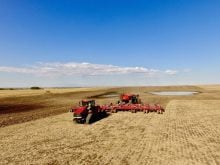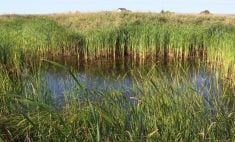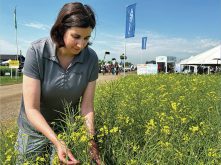In many parts of the Prairies last summer it was hot and exceptionally dry as drought conditions persisted through the season. One of the consequences for farmers was spray operations with pest control applications may have been less effective than usual.
Tom Wolf, a sprayer expert and scientist at Agrimetrix Research and Training in Saskatoon, Sask., says the reason for that is the combination of high temperatures and low humidity can cause coverage and efficacy issues due to the rapid evaporation of spray drops.
Read Also

Claas brings 1000 Series SP forage harvesters to Canada
In mid-August, Claas unveiled its new line of Jaguar forage harvesters at an event in Visalia, California, deep in the heart of that state’s dairy region.
“We had this hot, dry condition basically throughout the entire summer and so evaporation would have been an issue,” says Wolf. The best strategy in this case is to use coarser sprays because this will keep the spray droplets from evaporating too quickly, he says.
“It seems hard to believe, but even in the short time droplets are in flight between the boom and the canopy, a significant amount of evaporation does occur,” says Wolf. “The small droplets do get significantly smaller even in the few seconds that they’re airborne.”
Wolf says larger droplets will also last much longer on the plant and have a greater chance of being absorbed. “Retaining the lifetime of that drop is really a big factor.”
Hot, dry conditions can also contribute to spray drift. Wolf says the best tool for avoiding that is to, once again, opt for a coarser spray to reduce the drift effect.
Consider Delta T
Another useful tool for applicators is Delta T, a weather parameter originally devised in Australia as a way to determine the best time to go in and spray when temperatures are high and humidity is low. The higher the Delta T value, the drier the atmosphere is and the greater the potential for spray drops to evaporate.
“Delta T is really another word for wet bulb depression, and it more accurately gives an indication of how fast water evaporates. It’s much better than relative humidity and it really is the best way to measure evaporation of water,” says Wolf.
“Relative humidity has different rates of evaporation at different temperatures,” he adds. “At a low temperature, 50 per cent RH means relatively low evaporation rates, but at a high temperature, 50 per cent RH means a pretty high evaporation rate. It’s not really a good parameter. Delta T is more straightforward.”
High Delta T values can reduce droplet survival in the air. Target and low Delta T values encourage droplet survival, which can increase the risk of spray drift. The optimal Delta T range for spraying, according to the Aussies, is between 2 C and 8 C.
“When you get to 10 C or higher, your evaporation loss might be more than you can handle,” says Wolf, adding other factors such as pesticide formulation and droplet size will also affect evaporation rate.
Wolf states Delta T isn’t something Prairie farmers usually need to consider in May and June, but it becomes more important for later-season applications, a time when more fungicides and growth regulators are typically applied. “You want to pay more attention to those July and August sprays, when it can be very hot and dry.”
Several devices such as the Kestrel 3500 Delta T Pocket Wind Meter are available to producers to monitor Delta T values, which will typically rise and fall with air temperatures throughout the day. If Delta T values get too high, applicators may want to consider suspending spraying operations, but as Wolf points out, there may be times when that just isn’t practical.
“Let’s say the Delta T is 10. We’re in the zone where we really shouldn’t be spraying, but what often happens is you’ve committed to a task. Maybe you are in a remote location, say your tender truck is there, everything’s ready to go and you’ve got the job to do,” he says.
“Are you going to pull out of that job just because the Delta T value is wrong? Probably not. There’s a lot riding on getting the job done,” Wolf adds. “I don’t want to say don’t spray when the Delta T value is high, but I’d rather say consider how you can mitigate the negative effects of that high Delta T value, then do that and spray anyway.”
Mitigation measures can include increasing water volume and droplet size and using lower booms. “The same things we use to control spray drift can also reduce the impact of Delta T,” says Wolf.
















